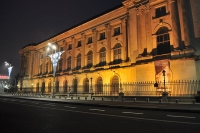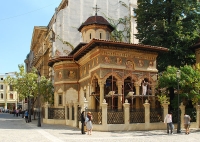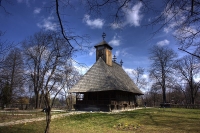
Housed in the former 1900 Post Office building is one of Bucharest's most important museums, the National History Museum. Spread throughout 41 rooms, the exhibits recount the country's development from prehistoric times to the 1920s.Located inside the former Postal Services Palace, the museum is housed next to a philatelic museum, housing hundreds of thousands of historic stamps. Interestingly, the museum had to be closed briefly for reconstruction in 2012 when a late-medieval archaeological site was discovered under the building.The highlight is the basement National Treasury, which is crammed with a dazzling display of gold, jewellery, and valuable Neolithic curios. It is the biggest and best museum in the country and affords an excellent opportunity to get to grips with the exciting history of Romania.
Address : Calea Victoriei 12
E-mail : [email protected]
Website : www.mnir.ro
Telephone : +40 21 315 8207
Opening times : Wednesday to Sunday 10am-6pm, Monday and Tuesday closed.

Built by former dictator Nicolae Ceausescu, the colossal Palace of Parliament is the largest civilian administrative building in the world. It is an immense structure that took 20,000 workers and 700 architects to build, and cost billions. It has 12 stories, 1,100 rooms, a 328 foot-long (100m) lobby, and four underground levels including an enormous nuclear bunker.Started in 1984, the dictator intended it to be the headquarters of his Communist Government, but it was still unfinished when he was executed in 1989. Today it houses the seat of Romania's Parliament (which occupies only 30 percent of the building) and is an international conference centre. Widely viewed as a personification of his obsession with the grandiose and excessive, the construction entailed the demolition of a quarter of Bucharest's historic centre, including 26 churches, and the relocation of 40,000 inhabitants from their 19th century homes to new developments on the outskirts.Built and furnished exclusively from Romanian materials, the building reflects the work of the country's best artisans. A guided tour takes visitors through a small section of dazzling rooms, huge halls and quarters used by the Senate (when not in session). The interior is a luxurious display of crystal chandeliers, mosaics, oak panelling, and marble, gold leaf and stained glass windows, and even the floors are covered in rich carpets. The largest room has a sliding roof wide enough for a helicopter to enter. Tour guides delight in recounting tales of the vast amounts of money that went to waste in decorating and re-decorating its rooms.
Address : Strada Izvor 2-4
Website : www.cdep.ro/cic

The tiny but remarkable Stavropoleos Church was built in 1724, designed by a Wallachian prince renowned for his religious architectural accomplishments, and is one of the oldest churches in Bucharest. Built using a combination of Romanian and Byzantine architecture, the beautiful façade and a delicately carved columned entrance, give but a taste of the beauty that lies within. Surrounded by a peaceful garden, it is an architectural jewel, with intricate frescoes and religious icons.Attached to the church is Stravropoleos Monastery. The Monastery specialises in Byzantine music and has an impressive choir and Romania's largest collection of Byzantine music books. The monastery's library contains more than 8,000 books, including a significant number of old manuscripts and printed works.
Address : Stavropoleos Street
Website : www.stavropoleos.ro
Telephone : +40 21 313 4747

One of Bucharest's finest sights is the Village Museum, situated within the Herastrau Park alongside a picturesque lake. It is a fascinating outdoor museum with a collection that spans more than 300 buildings representing the history and design of Romania's rural architecture, including peasant homes, barns, wooden churches, and Transylvanian houses from all regions of the country to recreate a village setting.Traditionally dressed peasant workers portray life during the 16th and 17th centuries along with everyday tools and accessories. Traditional crafts are also for sale around the site.
Address : 28-30, Șoseaua Pavel Dimitrievici Kiseleff
E-mail : [email protected]
Website : www.muzeul-satului.ro
Telephone : +40 21 317 9103
Opening times : Tuesday to Sunday 9am-7pm, closed Monday.

Travel Guide powered by Word Travels, copyright © 2023 Globe Media Ltd. By its very nature information in this travel guide is subject to change at short notice and travellers are urged to verify information on which they're relying with the relevant authorities. Neither Globe Media Ltd nor Travel Vogue can accept any responsibility for any loss or inconvenience to any person as a result of information contained above.